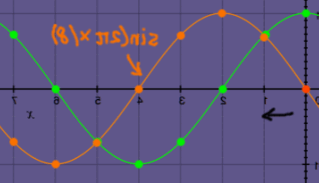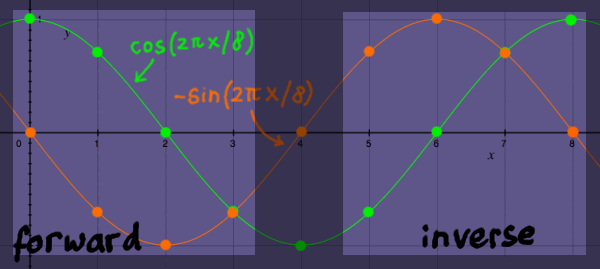
I have learnt, and echoed, that reversal in time domain is
equivalent to conjugation in frequency domain. When I tried to
exploit this equivalence for the first time in a practical application,
a complication for discrete time presented itself. I could have known
that before, had I better inspected my own illustrations. The following
is copied from my page Fourier Matrix:
 |
With that plot I illustrated how the conjugate of a complex
sinusoidal function could be derived by going in the reverse direction,
starting from zero. But look what happens when we reverse a N=8 complex
array containing the fundamental sinusoid:
  |
These are not exactly a conjugate pair. It is phase-shifted, by one
sample. If I compensate for this phase-shift, it looks better:
  |
I shifted the illustration such that the original samples 0 till 7
coincide with sample 1 till 8 of the flipped picture.
One sample, is that such a big deal? For an inverse FFT, I tried
using a reversed array of complex roots of unity, instead of a
conjugated array. That is how I encountered the problem. The effect can
hardly be overlooked. Below is an example for N=64. The left picture is
with the roots conjugated, while the right picture is with the roots
array reversed:
 |
 |
I am still digesting the implications of this one-sample
discrepancy. Anyway, I was looking for a bitwise method of inverting an
FFT function, such that it can be used for both directions. For this
case, it is not so problematic.
Recall that only half a cosine and sine function are needed for the
twiddle factors. Below is an impression of that. For the inverse FFT
the second half of the function points could be used, reading them
reversed and with a one sample shift. Since we are the creators of the
arrays, we are free to add one sample, but it is not even necessary
since we normally skip twiddling in case of identities.
 |
I did code for an invertible FFT function using the reversed array
with complex roots of unity. But later I have abandoned this, because
there is a better option. Since we can organise the arrays in any
fashion that suits our needs, I chose to interleave them in such a way
that the indexes for the inverse FFT need not be read in reverse
direction, but only shifted by one position. Here is an impression of
cutting, stretching, reversing and interleaving:
 |
The even indexes are for the forward transform and the odd indexes
for the inverse. We already knew there is only one difference for the
inverse twiddle factors: the sine part has opposite sign. It could be
more advantageous to just use the half functions and make the twiddle
code conditional, specially for systems with small (cache)memory. But
since I am determined to find a bitwise alternative, I will continue
with that. Here is a function for interleaved complex roots of unity:
|
N = 1<<logN; for(n=0; n<N; n+=2) |
In the function definition, a boolean argument 'invert' is included
which shall be true for inverse FFT, and false for forward
FFT.(#include
<stdbool.h> in the header). The boolean is used as a switch for a
one sample offset. This needs to be done only once per FFT stage, as
the offset is kept during decrement of the rootindex variable.
void fft(double *real, double *im, double *realtwiddle, double *imtwiddle, int logN, bool invert) { unsigned int N, even, odd, span, rootindex; unsigned int phase; // angle of primitive root of unity unsigned int rootmask; // for modulo N computation double temp; N = 1<<logN; rootmask = N-1; phase = 1; // phase bias because of interleaved roots of 1 for(span=N>>1; span; span>>=1) { phase <<=1; // update in every FFT stage rootindex = (N-phase) ^ invert; // initialize in every FFT stage for(even=N-span; even;) // iterate over the dual nodes { even--; odd = even|span; // iterate over odd blocks only even = odd ^ span; // even part of the dual node pair temp = real[even] + real[odd]; real[odd] = real[even] - real[odd]; real[even] = temp; temp = im[even] + im[odd]; im[odd] = im[even] - im[odd]; im[even] = temp; if(rootindex) // rootindex[0] has an identity { temp=realtwiddle[rootindex]*real[odd]-imtwiddle[rootindex]*im[odd]; im[odd]=realtwiddle[rootindex]*im[odd]+imtwiddle[rootindex]*real[odd]; real[odd] = temp; } rootindex -= phase; // decrement rootindex rootindex &= rootmask; // modulo N computation } // end of loop over nodes } // end of loop over FFT stages } //end of fft function |
The direction of the rotations is now dependent on the 'invert'
argument. A simple true or false invokes more bitwise logic, and does
it's work without conditional expression. Admittedly, that is a rather
futile detail. Specially since it does not seem to save one
microsecond. Bah...
That was for the twiddle factors. The normalisation in the inverse
FFT also needs special attention. I have done a page on normalisation matters,
and I will not repeat the considerations here in detail, but just use
1/N normalisation in the forward transform.
void fft(double *real, double *im, double *realtwiddle, double *imtwiddle, int logN, bool invert) { unsigned int N, even, odd, span, rootindex; unsigned int phase; // angle of primitive root of unity unsigned int rootmask; // for modulo N computation and for direction double temp, norm; N = 1<<logN; norm = 1./N; // 'normalisation' factor rootmask = N-1; phase = 1; // phase bias because of interleaved roots of 1 for(span=N>>1; span>1; span>>=1) { phase <<=1; // update in every FFT stage rootindex = (N-phase) ^ invert; // initialize in every FFT stage for(even=N-span; even;) // iterate over the dual nodes { even--; odd = even|span; even = odd ^ span; // iterate over even blocks only temp = real[even] + real[odd]; real[odd] = real[even] - real[odd]; real[even] = temp; temp = im[even] + im[odd]; im[odd] = im[even] - im[odd]; im[even] = temp; if(rootindex) // rootindex[0] has an identity { temp=realtwiddle[rootindex]*real[odd]-imtwiddle[rootindex]*im[odd]; im[odd]=realtwiddle[rootindex]*im[odd]+imtwiddle[rootindex]*real[odd]; real[odd] = temp; } rootindex -= phase; // decrement rootindex rootindex &= rootmask; // modulo N computation } // end of loop over nodes } // end of loop over FFT stages, except last one invert = !invert; // invert the boolean for faster check for(even=N; even; ) // last FFT stage including normalisation { even -= 2; // attention, decrement at unusual place odd = even|1; temp = real[even] + real[odd]; real[odd] = (real[even] - real[odd]); real[even] = temp; temp = im[even] + im[odd]; im[odd] = (im[even] - im[odd]); im[even] = temp; if(invert) // recall that invert = !invert { real[even] *= norm; // 'normalisation' only in forward transform im[even] *= norm; real[odd] *= norm; im[odd] *= norm; } } // end of last FFT stage } //end of function |
One obvious test for code like this, is to have it inverse-transform
it's own result. But in order to do so, we need a bitreversed sorting
inbetween, and after the inverse transform. The algorithm is for
input in natural order and output in decimated order. To be honest, I
completely forgot about the whole decimation thing, while developing my
freaky bitwise FFT inverter. That is stupid eh? It is time to figure
out the bit reversal. See the next page.